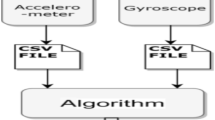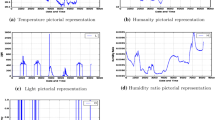Abstract
Advances in digital and communication technologies have led to the rapid development of advanced technologies such as machine learning, the Internet of Things, and cloud systems that automate the work process in healthcare, education, and multiple industries. Nowadays, the elderly are often left alone at home, so it is necessary to track their health and behavioral activity. In this paper, modeling a context-aware automated elderly activity monitoring system is proposed to monitor elderly biological conditions and behavioral activity changes uninterruptedly. In the proposed system, sensory data is collected through a variety of sensor devices. Based on captured sensory signals, elderly health forecasting is performed using signal processing, machine learning approaches of support vector machine, and cloud-assisted context-aware on-demand and pro-active healthcare support. The simulation outcome exhibits better performance achieved by the proposed system for elderly activity recognition and healthcare than the existing Random forest classifier. The comparative analysis shows that SVM's proposed system achieves a 94% accuracy rate in activity recognition.







Similar content being viewed by others
References
Zhang, H.-B., Zhang, Y.-X., Zhong, B., Lei, Q., Yang, L., Du, J.-X., & Chen, D.-S. (2019). A comprehensive survey of vision-based human action recognition methods. Sensors, 19(5), 1005.
Solórzano, S., Rojas-Ortiz, M., López-Molina, R.-A., Clairand, J.-M., & Pozo-Espín, D. (2018). Home tele-assistance system for elderly or disabled people in rural areas. In 2018 International Conference on eDemocracy and eGovernment (ICEDEG) (pp. 380–385). IEEE.
Pal, D., et al. (2018). Internet-of-things and smart homes for elderly healthcare: An end user perspective. IEEE Access, 6, 10483–10496.
"India: Age distribution from 2008 to 2018". https://www.statista.com/statistics/271315/age-distribution-inindia/-::text=This%20statistic%20depicts%20the%20age,over%2065%20years%20of%20age. Retrieved on 15 June 2020.
Kumar, A., et al. (2011). Review research paper fall: The accidental injury in geriatric population. Journal of Indian Academy of Forensic Medicine, 33, 0971–0973.
Kumar, A., et al. (2011). Fall: The accidental injury in geriatric population. Journal of Indian Academy of Forensic Medicine, 33(2), 175–178.
Dash, S., et al. (2020). Deep learning techniques for biomedical and health informatics. Berlin: Springer.
Dhillon, A., & Singh, A. (2019). Machine learning in healthcare data analysis: A survey. Journal of Biology and Today's World, 8(6), 1–10.
Rong, G., et al. (2020). Artificial intelligence in healthcare: Review and prediction case studies. Engineering, 6, 291–301.
Ghassemi, M., et al. (2020). A review of challenges and opportunities in machine learning for health. AMIA Summits on Translational Science Proceedings, 2020, 191.
Ravi, D., Wong, C., Lo, B., & Yang, G. (2017). An in-depth learning approach to on-node sensor data analytics for mobile or wearable devices. IEEE Journal of Biomedical and Health Informatics, 21(1), 56–64.
Lakshmanaprabu, S., et al. (2019). Online clinical decision support system using optimal deep neural networks. Applied Soft Computing, 81, 105487.
Cai, Y. et al. (2018). Software defined status aware routing in contentcentric networking. In 2018 International conference on information networking.
Hussain, A., et al. (2015). Health and emergency-care platform for the elderly and disabled people in the Smart City. Journal of Systems and Software, 110, 253–326.
Lee, S.-K., et al. (2014). Prediction model for health-related quality of life of elderly with chronic diseases using machine learning techniques. Healthcare Informatics Research, 20(2), 125–134.
Hamim, M., et al. (2019). IoT based remote health monitoring system for patients and elderly people. In 2019 International conference on robotics, electrical and signal processing techniques (ICREST).
Bulbul, E., Cetin, A., & Dogru, I. A. (2018). Human activity recognition using smartphones. In 2018 2nd international symposium on multidisciplinary studies and innovative technologies (ismsit) (pp. 1–6).
Human Activity Using an Artificial Neural Network and Smartwatch. Wireless Communications and Mobile Computing (2018).
Fong, S., Liang, J., Fister, I., & Mohammed, S. (2015). Gesture recognition from data streams of human motion sensor using accelerated PSO swarm search feature selection algorithm. Journal of Sensors. https://doi.org/10.1155/2015/205707.
Zhang, S., Wei, Z, Nie, J., Huang, L., Wang, S., & Li, Z. (2017). A review on human activity recognition using vision-based method. Journal of Healthcare Engineering.
Subasi, A., Khateeb, K., Brahimi, T., & Sarirete, A. (2020). Human activity recognition using machine learning methods in a smart healthcare environment. In Innovation in health informatics (pp. 123–144). Academic Press.
Voicu, R. A., Dobre, C., Bajenaru, L., & Ciobanu, R. I. (2019). Human physical activity recognition using smartphone sensors. Sensors, 19(3), 458.
Chen, Z., Jiang, C., & Xie, L. (2019). A novel ensemble elm for human activity recognition using smartphone sensors. IEEE Transactions on Industrial Informatics, 15(5), 2691–2699.
Yu, S., & Qin, L. (2018). Human activity recognition with smartphone inertial sensors using bidir-lstm networks. In 2018 3rd international conference on mechanical, control and computer engineering (icmcce) (pp. 219–224).
Li, P., Wang, Y., Tian, Y., Zhou, T., & Li, J. (2017). An automatic user-adapted physical activity classification method using smartphones. IEEE Transactions on Biomedical Engineering, 64(3), 706–714.
Barua, A., Masum, A. K. M., Hossain, M. E., Bahadur, E. H., & Alam, M. S. (2019). A study on human activity recognition using gyroscope, accelerometer, temperature and humidity data. In 2019 international conference on electrical, computer and communication engineering (ecce) (pp. 1–6).
Cvetkovic, B., Szeklicki, R., Janko, V., Lutomski, P., & Lustrek, M. (2017). Real-time activity monitoring with a wristband and a smartphone. Information Fusion, 43, 77–93.
Nurhanim, K., Elamvazuthi, I., Izhar, L. I., & Ganesan, T. (2017). Classification of human activity based on smartphone inertial sensor using support vector machine. In 2017 IEEE 3rd international symposium in robotics and manufacturing automation (Roma) (pp. 1–5).
Tian, Y., & Chen, W. (2016). Mems-based human activity recognition using smartphone. In 2016 35th Chinese control conference (ccc) (pp. 3984–3989).
Wang, A., Chen, G., Yang, J., Zhao, S., & Chang, C. (2016). A comparative study on human activity recognition using inertial sensors in a smartphones. IEEE Sensors Journal, 16(11), 4566–4578.
Chen, Y., & Xue, Y. (2015). A deep learning approach to human activity recognition based on single accelerometer. In 2015 IEEE international conference on systems, man, and cybernetics (pp. 1488–1492).
Zeng, M, Nguyen, L. T., Yu, B., Mengshoel, O. J., Zhu, J., Wu, P., & Zhang, J. (2014). Convolutional neural networks for human activity recognition using mobile sensors. In 6th international conference on mobile computing, applications, and services (pp. 197–205).
Anguita, D., Ghio, A., Oneto, L., Parra, X., & Reyes-Ortiz, J. L. (2013). Energy efficient smartphone-based activity recognition using fixed-point arithmetic. Journal of Universal Computer Science. Special Issue in Ambient Assisted Living: Home Care, 19(9), 1295–1314.
Author information
Authors and Affiliations
Corresponding author
Additional information
Publisher's Note
Springer Nature remains neutral with regard to jurisdictional claims in published maps and institutional affiliations.
Rights and permissions
About this article
Cite this article
Sujaya, B.L., Bhaskar, R.S. A Modelling of Context-Aware Elderly Healthcare Eco-System-(CA-EHS) Using Signal Analysis and Machine Learning Approach. Wireless Pers Commun 119, 2501–2516 (2021). https://doi.org/10.1007/s11277-021-08341-2
Accepted:
Published:
Issue Date:
DOI: https://doi.org/10.1007/s11277-021-08341-2




